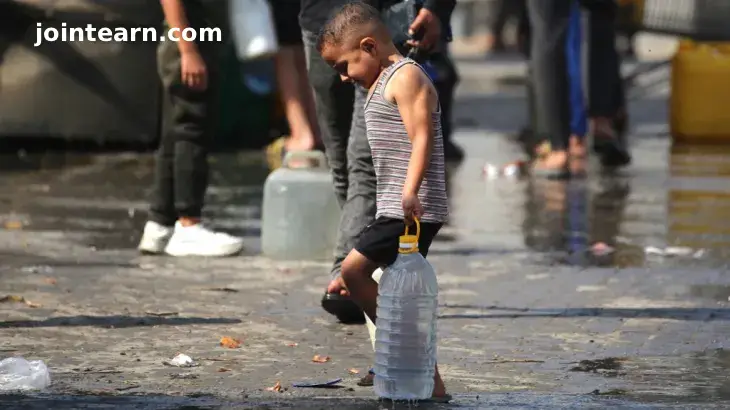
Gaza is facing a deadly environmental crisis as the ongoing conflict with Israel has not only destroyed homes and medical facilities but also poisoned the region’s water supply and farmlands. Weeks into a fragile ceasefire, which Israel has reportedly violated almost daily, the humanitarian situation is worsening, with contaminated water now posing lethal risks to displaced families across the enclave.
Devastation in Gaza City’s Sheikh Radwan Neighborhood
In Gaza City’s Sheikh Radwan neighborhood, what was once a lively residential area has become a wasteland. Homes lie in rubble, and a crucial rainwater pond, previously a source of water for residents, has turned into a hazardous reservoir filled with raw sewage and debris.
Pregnant mother Umm Hisham, forced to live near the contaminated water, described the dangers her family faces:
“We took refuge here, around the Sheikh Radwan pond, with all the sufferings you could imagine, from mosquitoes to sewage with rising levels, let alone the destruction all around. All this poses a danger to our lives and the lives of our children.”
The destruction of pumps, electricity, and sanitation systems has caused contaminated water to rise, threatening nearby homes and temporary shelters. Municipal officer Maher Salem warned of severe risks:
“Foul water levels have exceeded 6 metres [20ft] high without any protection; the fence is completely destroyed, with high possibility for any child, woman, old man, or even a car to fall into this pond.”
Contaminated Water and Public Health Risks
Stagnant and polluted water poses a severe risk of disease outbreaks, particularly among children. Many families have no alternative water sources and are forced to rely on wells, water containers, or trucks, all of which are often contaminated.
Al Jazeera reporter Hani Mahmoud noted:
“Families know that the water they get from the wells and from the containers or from the water trucks is polluted and contaminated … but they don’t have any other choice.”
Environmental and Agricultural Catastrophe
At the COP30 Climate Summit in Brazil, Palestinian Ambassador Ibrahim al-Zeben described Gaza’s situation as an environmental catastrophe compounded by ongoing violence:
“Gaza is suffering because of the genocide that Israel continues to wage, a war that has created nearly a quarter of a million victims and produced more than 61 million tonnes of rubble, some of which is contaminated with hazardous materials. The deliberate destruction of sewage and water networks has led to the contamination of groundwater and coastal waters.”
He also highlighted that much of Gaza’s agricultural land has been destroyed, leaving the population vulnerable to food insecurity and famine, with food increasingly used as a weapon in the conflict.
UN Reports on Water Contamination
A United Nations Environment Programme (UNEP) report in September warned that freshwater supplies in Gaza were “severely limited and much of what remains is polluted.” The collapse of sewage treatment infrastructure, destroyed piped systems, and reliance on cesspits have likely contaminated the aquifer, which provides drinking water to much of the population.
Daily Struggles of Displaced Families
Back in Sheikh Radwan, the human toll of the environmental crisis is stark. Displaced families navigate through foul, disease-prone water in search of basic necessities like water, food, and bread. As Mahmoud summarized:
“When every day is a fight to find water, food, and bread, safety becomes secondary.”
The combination of war, environmental contamination, and lack of access to clean water underscores the humanitarian disaster in Gaza, with immediate international aid and intervention urgently needed to prevent further loss of life.


Leave a Reply